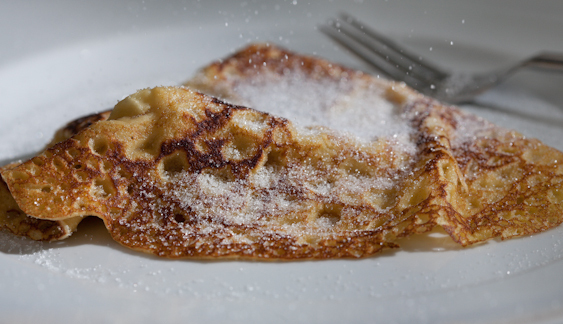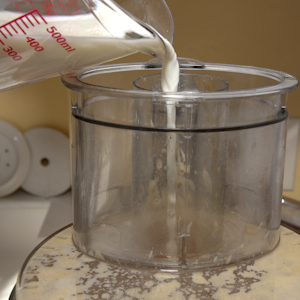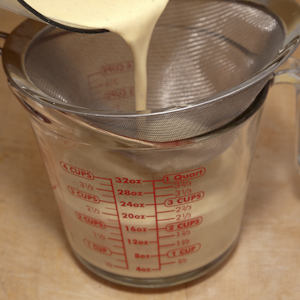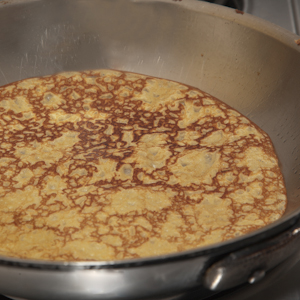Plain Sugared Crêpes

introduction
You would think the lilting circumflex at its very center might have saved the crêpe from the ignoble flames of tableside showmanship that plagued it for years. Or that the miserly adjectives standing in its wake might, over time, have given way to those more favorable. But as much as we love crêpes, we consign ourselves to hating most of them and acknowledge they deserve all the criticism they get: yes, they are dry and flavorless, flabby and eggy, pale and drawn. As beautiful as a crêpe should be, it is often just a sad, skinny pancake bunched up around a shapeless filling, or a thin heating pad, which, in melting a scoop of ice cream, grows cold itself.
I, Kay, have made hundreds of crêpes, and, if I daresay, they are excellent crêpes. I learned to make them while working for the catering division of the oldest department store in Berlin called KaDeWe, specifically for the Lenôtre pastry concern within that operation. I learned to make them because, in addition to my normal job of piping chou paste, glazing petit fours, icing tortes, or folding whipped cream into mousse with a cadre of well-trained German chefs and a French master, I was consigned on a regular basis to the crêpe stand on the floor below. There I swirled 15-inch round crêpes out on flat griddles three at a time—all day—for patrons visiting the vast food court in KaDeWe. It felt like a form of punishment. The crêpes, however, were extraordinary, lacy and brown, with the irresistible scent of brown butter and liqueur that drew crowds. During my exile at the crêpe stand, I learned more about crêpes than I’d ever expected to know, and developed a real taste for them (which I indulged back by the dishwasher when the stand was empty). I did not depart KaDeWe with the Lenôtre crêpe recipe, but palate memory served me well. I’ve gotten very, very close to re-creating these fabulous crêpes—close enough to call them a match—and I’ve made them now for years at dinner parties, and just for fun—because nothing is more fun than eating a hot crêpe straight out of the pan with butter and sugar. They have acquired a significant fan base. Now I have redrafted the recipe with Anson Mills Colonial Style Fine Cloth-Bolted Pastry Flour. It is my very favorite Anson Mills product and my very favorite recipe. I cannot offer you more than that.
Baking Notes
A crêpe is not difficult to make. And a good crêpe is not more difficult to make than a bad one. You need a recipe with enough butter for the crêpe to brown to supple crispness and flavor without turning stiff and dry. You need the correct egg, flour, and milk ratios so the crêpe stays creamy inside. You need a well-seasoned pan whose diameter does not exceed that of the burner, and some pretty serious heat—not steak-searing heat, but not cautious warming heat either. We favor cast iron for producing the gorgeous brown lace that is a perfect crêpe, but its heft makes for heavy handling. Cast iron is suited to griddle cookery in which the crêpe is stroked thin with a T-shaped wooden spatula and the pan is not manipulated by the wrist. If you have those things, use them.
If you’re working with a skillet, forget cast iron. Your wrist will never make it through the deft machinations necessary to move the batter around the pan. We don’t recommend nonstick pans under any circumstance when it comes to crêpes—a crêpe must stick to and grip the bottom of the pan to develop the correct lacy texture, not skate around without purchase. Our favorite pan turns out to be a very basic 10-inch All-Clad skillet seasoned to within an inch of its life, and forbidden to cook anything but crêpes.
The prettiest side of the crêpe is the side first down in the pan. To display its best side, run the spatula under the crêpe in the pan at its midsection, lift it as a half circle, place it on the plate, slide the spatula out, and fold the crêpe into a triangle. Crêpes also taste fabulous rolled into a log and eaten in a few bites.
What makes this recipe in part so fine is the sexy combination of rum and orange liqueur with brown butter. Should you wish to forego alcohol in the batter, by all means do so—substitute ½ teaspoon of vanilla and add another 2½ tablespoons of milk—but the flavor dimensionality of the crêpes will be diminished.
By the way, the Lemon Butter we run with our Buckwheat Buttermilk Pancakes would be a superb accessory to these crêpes.
equipment mise en place
For this recipe, you will need a small heavy-bottomed saucepan; a wooden spoon; a food processor or stand mixer; a rubber spatula; a fine-mesh sieve; a 1-quart liquid measuring cup or similarly sized vessel with a pour spout; a metal spatula; and a well-seasoned 10-inch skillet or crêpe pan.
-
for the crêpe batter:
-
4ounces (8 tablespoons) unsalted European-style butter
-
3large eggs
-
4.7ounces (1 cup) Anson Mills Colonial Style Fine Cloth-Bolted Pastry Flour
-
5teaspoons sugar
-
½teaspoon fine sea salt
-
8ounces (1 cup) whole milk
-
1½tablespoons dark rum (if you’re making Crêpe Cake with Roasted Apples and Reduced Cider Syrup, use Calvados)
-
1½tablespoons Cointreau or Grand Marnier
-
-
for cooking the crêpes:
-
1.5ounces (3 tablespoons) unsalted European-style butter
-
-
for dressing the crêpes:
-
Softened unsalted European-style butter or Lemon Butter
-
Sugar
-
-
Make the crêpe batter: Melt the butter in a small heavy-bottomed saucepan over low heat, stirring with a wooden spoon to scrape the browning milk solids back into the butter, until the butter is the color of a hazelnut in the shell and the kitchen smells miraculous, 3 to 5 minutes. Pull the pan off the heat and set it aside to cool just slightly.
-
If using a food processor: Process the eggs until well combined. With the machine running, add the flour, sugar, and salt and process until the mixture is smooth and shiny and drips heavily from a spoon (fig. 2.1), pausing the machine once or twice to scrape down the sides of the bowl. With the machine running, pour in the warm brown butter (fig. 2.2), pausing once to scrape down the sides of the bowl. As the machine continues to run, add the milk (fig. 2.3), rum, and liqueur. Pour the batter through a fine-mesh sieve set over a 1-quart liquid measuring cup or a similarly sized vessel with a pour spout (fig. 2.4). Cover and refrigerate for at least 2 hours or up to 24.\n\nIf using a stand mixer: Beat the eggs with the flat beater on medium speed until combined, about 20 seconds. Reduce the heat to low and stir in the flour, sugar, and salt. Increase the heat to medium-high and continue to beat, scraping down the bowl from time to time, until the mixture is smooth and shiny and drips heavily from a spoon. Reduce the heat to low and add the warm butter in a slow, steady stream, scraping the sides of the bowl as needed. With the mixer running, add the milk in 3 additions, scraping the sides of the bowl. Stir in the rum and liqueur. Pour the batter through a fine-mesh sieve set over a 1-quart glass measuring cup or a similarly sized vessel with a pour spout. Cover and refrigerate for at least 2 hours or up to 24.
-
Clarify the butter for cooking the crêpes: Melt the butter in a small saucepan over low heat. Remove the pan from the heat, tilt it gently, and, using a spoon, skim off and discard the foam from the surface. Spoon the clear yellow butterfat into a small bowl; discard the water and milk solids left in the pan. Set the clarified butter aside.
-
Cook and serve the crêpes: Heat a well-seasoned 10-inch skillet or crêpe pan over medium-high heat for 5 minutes. Add ½ teaspoon of the clarified butter to the skillet—it should smoke—and polish the surface with folded paper towels to glaze it with butter. Drop in teaspoon or so of batter to test the heat. If the heat is correct, the skillet will sizzle appreciatively and the bottom of crêpe will show lacy brown blisters when lifted with the tip of a metal spatula; if it is not, the bottom will be smooth, like a pancake. When the temperature is correct, pour about ⅓ cup of batter across the half of the skillet opposite the handle, lift the skillet, and begin tilting it back and forth to coat the entire surface with a thin, even layer of batter (fig. 4.1). The skillet should be hot enough to grip the batter as it travels across the surface and issue the sound of distant, but enthusiastic, applause. Cook the crêpe until lacy brown on the bottom, about 1 minute (or less, depending on your burner and pan), use an icing spatula to carefully flip it (fig. 4.2), and cook the second side until nicely browned, 30 to 45 seconds (fig. 4.3). Serve the crêpe hot, folded into quarters, lacy side facing out. Glide a pat of butter over the top and finish with a shower of granulated sugar. Don’t stand on ceremony by holding the finished crêpes in a warm oven and serving them all at once. It’s every man, woman, or child for himself, herself, or itself in this scenario, and the cook gets no rest!
-
-
2.1

-
2.2

-
2.3

-
2.4

-
-
-
4.1

-
4.2

-
4.3

-